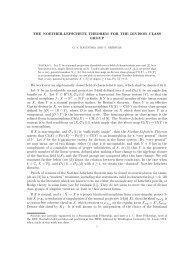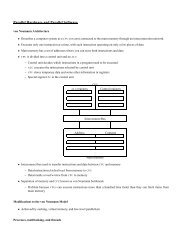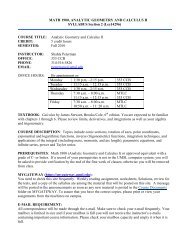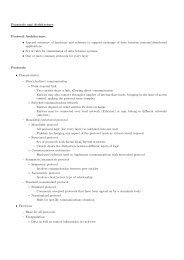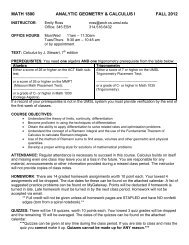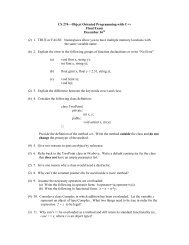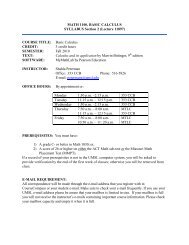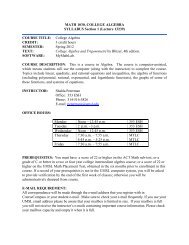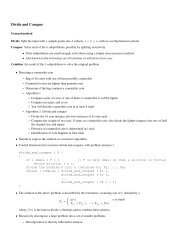here - UMSL : Mathematics and Computer Science - University of ...
here - UMSL : Mathematics and Computer Science - University of ...
here - UMSL : Mathematics and Computer Science - University of ...
You also want an ePaper? Increase the reach of your titles
YUMPU automatically turns print PDFs into web optimized ePapers that Google loves.
IEEE TRANS. SIGNAL PROC. 14<br />
Theorem 2: Suppose FIR filter banks {p, q (1) , q (2) } <strong>and</strong> {˜p, ˜q (1) , ˜q (2) } are given by<br />
[p(ω), q (1) (ω), q (2) (ω)] T = U n (M T ω)U n−1 (M T ω) · · · U 0 (M T ω)I 0 (ω), (39)<br />
[˜p(ω), ˜q (1) (ω), ˜q (2) (ω)] T = 1 3Ũn(M T ω)Ũn−1(M T ω) · · · Ũ0(M T ω)I 0 (ω)<br />
for some n ∈ Z + , w<strong>here</strong> I 0 (ω) is defined by (15), each U k (ω) is a W (ω) in (37) or a ˜W (ω) in (38) for<br />
some parameters a k , b k , d k , <strong>and</strong> Ũk(ω) = (U k (ω) −1 ) ∗ is the corresponding ˜W (ω) in (38) or W (ω) in (37), then<br />
{p, q (1) , q (2) } <strong>and</strong> {˜p, ˜q (1) , ˜q (2) } are biorthogonal FIR filter bank with 6-fold axial symmetry.<br />
Next we consider the construction <strong>of</strong> biorthogonal √ 3-refinement wavelets based on the symmetric biorthogonal<br />
FIR filter banks given in (39). When we construct biorthogonal wavelets, we will intently construct the synthesis<br />
scaling function ˜φ to have a higher smoothness order, <strong>and</strong> the analysis scaling function φ to have a higher approximation<br />
order (or equivalently the analysis lowpass filter p(ω) to have a higher sum rule order). Approximation property<br />
<strong>of</strong> φ is very important for applications, see e.g. [51], [52]. If φ has approximation order K, then the decomposition<br />
algorithm with lowpass filter p(ω) preserves (discrete) polynomials <strong>of</strong> order K, <strong>and</strong> the decomposition algorithm<br />
with highpass filters q (1) (ω), q (2) (ω) annihilates (discrete) polynomials <strong>of</strong> order K. Smoothness <strong>of</strong> ˜φ is in general<br />
more important than that for φ since certain smoothness <strong>of</strong> ˜φ is required to assure the reconstructed image to have<br />
nice visual quality.<br />
First, we consider the filter banks given by (39) with n = 0. Let [p(ω), q (1) (ω), q (2) (ω)] T = ˜W 0 (M T ω)I 0 (ω) <strong>and</strong><br />
[˜p(ω), ˜q (1) (ω), ˜q (2) (ω)] T = 1 3 W 0(M T ω)I 0 (ω), w<strong>here</strong> ˜W 0 (ω) <strong>and</strong> W 0 (ω) are given by (38) <strong>and</strong> (37) respectively<br />
for some parameters a 0 , c 0 , d 0 . By solving the equations <strong>of</strong> sum rule order 1 for ˜p(ω), we have<br />
a 0 = 1 3 , d 0 = 1 − 6c 0 . (40)<br />
The resulting ˜p(ω) actually has sum rule order 2 (the conditions in (24) for ˜p(ω) with (α 1 , α 2 ) = (1, 0) <strong>and</strong><br />
(α 1 , α 2 ) = (0, 1) are automatically satisfied because <strong>of</strong> the symmetry <strong>of</strong> ˜p(ω)). If in addition, we choose c 0 = 1 18 ,<br />
then ˜p(ω) has sum rule order 3. This ˜p(ω) is the subdivision mask in [24]. However, in this case the resulting<br />
p(ω) does not have sum rule order 1. With a 0 , d 0 given by (40) for some c 0 , by solving the equations <strong>of</strong> sum rule<br />
order 1 for p(ω), we have c 0 = − 2 9 . However, in this case the corresponding ˜φ is not in L 2 (IR 2 ). Thus, the filter<br />
banks in (39) with n = 0 cannot generate scaling functions φ <strong>and</strong> ˜φ such that both <strong>of</strong> them are in L 2 (IR 2 ), <strong>and</strong><br />
hence, these filter banks cannot generate biorthogonal wavelets.<br />
Example 3: Let {p, q (1) , q (2) } <strong>and</strong> {˜p, ˜q (1) , ˜q (2) } be the biorthogonal filter banks given by (39) for n = 1 with<br />
[p(ω), q (1) (ω), q (2) (ω)] T = W 1 (M T ω)˜W 0 (M T ω)I 0 (ω),<br />
[˜p(ω), ˜q (1) (ω), ˜q (2) (ω)] T = 1 3 ˜W 1 (M T ω)W 0 (M T ω)I 0 (ω),<br />
w<strong>here</strong> ˜W 0 (ω), ˜W 1 (ω), <strong>and</strong> W 0 (ω), W 1 (ω) are given by (38) <strong>and</strong> (37) for some parameters a 0 , c 0 , d 0 <strong>and</strong> a 1 , c 1 , d 1<br />
respectively.<br />
We notice that the smoothness <strong>of</strong> φ, ˜φ is independent <strong>of</strong> some parameters, e.g. d 1 . In the following we let d 1 = 0.<br />
If<br />
a = c 1(1 − 2a 1 )<br />
2a 1<br />
, c = c 1(9a 1 − 1)(1 − 2a 1 )<br />
3a 1<br />
, d = c 1(36a 2 1 + 2a 1 − 1)<br />
a 1<br />
,<br />
then both p(ω) <strong>and</strong> ˜p(ω) have sum rule order 2. If we choose a 1 = 8<br />
81 , c 1 = 1, then the resulting φ is in W 0.1289 ,<br />
<strong>and</strong> ˜φ in W 1.3474 ; while if we choose a 1 = 1<br />
10 , c 1 = 1, then the resulting φ ∈ W 0.0911 , <strong>and</strong> ˜φ ∈ W 1.3777 . One may<br />
choose other values for a 1 , c 1 such that the resulting ˜φ is smoother. But ˜φ can only gain very slight increments <strong>of</strong><br />
smoothness order if its dual φ is in L 2 (IR 2 ). ♦<br />
Example 4: Let {p, q (1) , q (2) } <strong>and</strong> {˜p, ˜q (1) , ˜q (2) } be the biorthogonal filter banks given by (39) for n = 1 with<br />
[p(ω), q (1) (ω), q (2) (ω)] T = ˜W 1 (M T ω)˜W 0 (M T ω)I 0 (ω),<br />
[˜p(ω), ˜q (1) (ω), ˜q (2) (ω)] T = 1 3 W 1(M T ω)W 0 (M T ω)I 0 (ω),



